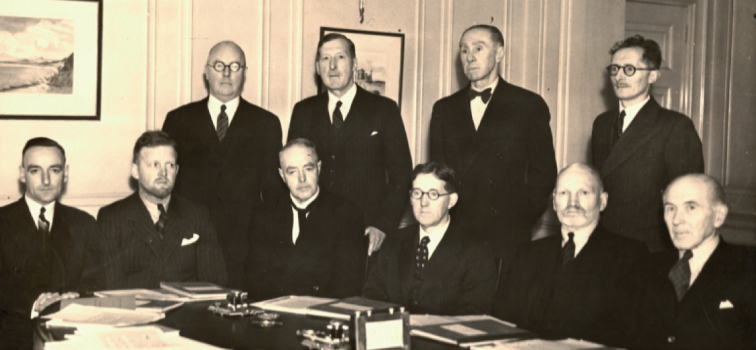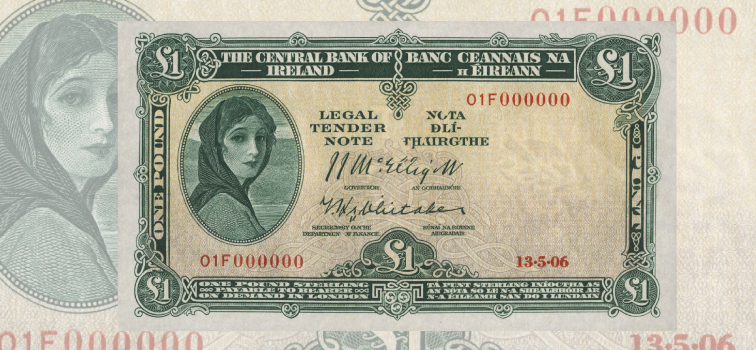Secrecy, Seals and Signatures: The First Meeting of Central Bank of Ireland
 (Photo: Seated l to r: David W. Coyle, Malachi Sweetman, John F. Punch, Joseph Brennan (Governor), William O’Brien, Timothy A. Smiddy. Standing l to r: R. T. McGuinness (Secretary to the Central Bank’s Board of Directors), Gabriel Brook, Rt. Hon.Lord Glenavy, James J. McElligot (second governor of the Central Bank))
(Photo: Seated l to r: David W. Coyle, Malachi Sweetman, John F. Punch, Joseph Brennan (Governor), William O’Brien, Timothy A. Smiddy. Standing l to r: R. T. McGuinness (Secretary to the Central Bank’s Board of Directors), Gabriel Brook, Rt. Hon.Lord Glenavy, James J. McElligot (second governor of the Central Bank))
What happens at the first meeting of a central bank?
We decided to find out by delving into our archive and examining “Minute Book No. 1”, which recorded the first ever meeting of Central Bank of Ireland.
The first thing we noticed upon opening the near eighty-year-old ledger was a newspaper cutting carefully glued into the time-worn first page.
Dated Friday 29 January 1943, the cutting was taken from Iris Oifigiúil, the official Gazette of the Government of Ireland.
Published under the authority of the then Minister for Finance, Seán T. Ó’Ceallaigh it reads:
“Notice is hereby given that the Board of the Central Bank of Ireland has been established and the following appointments have been made with effect as from 1st February, 1943.”
Listed below, a “who’s who” of twentieth century Ireland, starting with Joseph Brennan who was appointed for a seven-year term as the Central Bank’s first Governor.
After Brennan, the names of eight other men who made up the Central Bank’s first Board of Directors – clearly chosen at a time when diversity was not a consideration.
Among them, Timothy Smiddy, the academic, economist and diplomat who served as Ireland’s first official ambassador (to the United States) in 1924.
Also, James John McElligot, the son of a Tralee shopkeeper, who fought in the GPO during the Easter Rising, and would later go on to succeed Brennan as governor in 1953.  (Photo: The opening pages of The Central Bank of Ireland - Minute Book No.1. The cutting of the Iris Oifigiúil notice can be seen on page one while an impression of the new Central Bank seal was made at the top of page two.)
(Photo: The opening pages of The Central Bank of Ireland - Minute Book No.1. The cutting of the Iris Oifigiúil notice can be seen on page one while an impression of the new Central Bank seal was made at the top of page two.)
Oath of secrecy
The Iris Oifigiúil notice is the first item on 21 pages of exquisitely handwritten minutes recording the first meeting of the Central Bank of Ireland, which was held 1 February 1943 at 11.30am at Foster Place in Dublin city centre.
Administrative matters dominated this first meeting which reflected the dissolution of the old Currency Commission and transfer of powers and functions to its successor, what we now know as the Central Bank.
The second item of business for the newly-formed Board was to take an oath of secrecy.
Sworn in the presence of a Peace Commissioner, the oath bound the directors not to disclose “any information relative to the business, record, or books of any bank which may come to my knowledge by virtue of my position as the Governor or a Director of the Central Bank of Ireland.”
The penalty for breaking the oath?
A fine “not exceeding one hundred pounds”.
Next for the Board was to adopt the official seal for the newly formed Central Bank, an impression of which can be seen on page two of the ledger.
It was directed that the seal of the now dissolved Currency Commission should be “broken or defaced as to be incapable of being used”.
Lavery notes
After providing examples of their signed signatures the next item of business for the Board was the design of the country’s banknotes.
The design of the popular Series A notes, which featured Lady Lavery and better known simply as the “Lavery notes”, would remain unchanged.
However the notes needed to be updated to reflect that the issuing authority had changed and would bear the signature of the Governor of the Central Bank (An Ghobharnóir) rather than the Chairman of the Commission. (Photo: An image of the £1 note from the Series A Banknotes also known as the Lady Lavery notes, which served as official Irish currency from 1928 – 1977.)
(Photo: An image of the £1 note from the Series A Banknotes also known as the Lady Lavery notes, which served as official Irish currency from 1928 – 1977.)
The last item for discussion concerned the delegation of functions by the Board.
On this, it seems they either ran out of time or failed to reach agreement, with the minutes showing the matter was deferred for “further consideration”.
Central Bank Archive
Today, instead of a board of directors, Central Bank of Ireland has a Commission made up of internal and external appointees.
The Commission is responsible for ensuring that the statutory functions of the Central Bank are properly discharged and a public record of all Commission meetings is published on our website.
However, Minute Book No. 1 gives us a fascinating glimpse into the early life of the Central Bank.
The ledger is just one artefact of a vast repository of historical information held in the Central Bank’s Archive.
The Archive opened to the public for the first time in 2017 and holds over two hundred years’ worth of records, with the earliest material dating back to 1786.
It includes articles relating to all aspects of the Central Bank, including over 12,000 paper files as well as over 4,000 photographs.
You can access descriptions of catalogued archival material online and email: [email protected] to book a viewing appointment.
So why not browse our catalogue and book an appointment?
Who knows what you might discover?
See also: